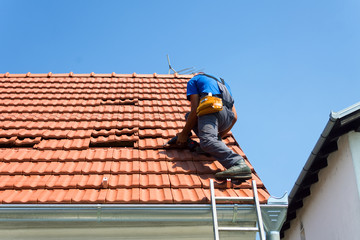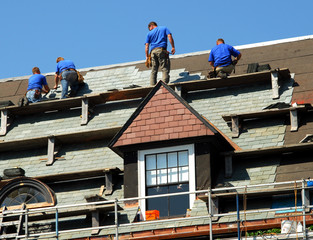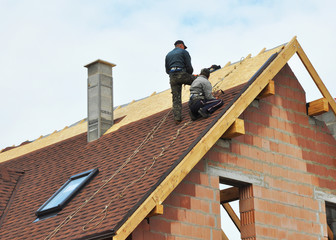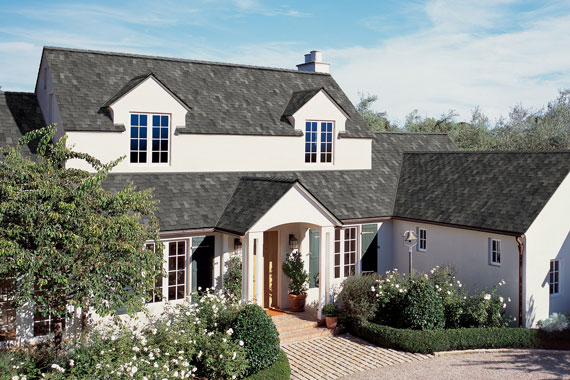When it comes to roofs, homeowners have a lot of choices. They can choose from asphalt shingles, wood, slate, clay, or concrete tiles. The roof is the top covering of a building, protecting against rain, snow, sunlight, extremes of temperature, and wind. The slope, or pitch, of the roof, is determined by design.

A regular inspection by a trained professional is necessary to detect problems that could lead to leaks. A routine checklist should be used to help document each inspection and any issues found, and it should be tailored for each type of roof.
A roof is the first line of defense against the elements of a building, protecting against rain, snow, sunlight, and extreme temperatures. The materials used in a roof have a significant impact on the building’s performance and lifespan. Various roofing materials are available, from natural wood shingles to clay tiles. Many newer roofing materials are eco-friendly and may even help cool the building by reflecting sunlight.
Traditional wood shingle, tar and asphalt shingle roofs are common in all States. They are relatively inexpensive, and can last for 50 years or more if properly maintained. Some newer wood shingles are made from recycled paper, a more sustainable resource.
Slate, a natural stone that can be quarried in many regions, is one of the most attractive and longest-lasting roofing materials available. It is heavy, however, and requires a roof structure that can support its weight. It also requires a highly specialized roofing installer, making it more expensive than other roofing options.
Metal roofing is a popular choice for commercial buildings and may be used in flat or sloped construction. Several different metals are in use, including galvanized steel (which uses zinc to prevent corrosion) and aluminum panels. Some of these are coated with paint or plastic to add weather resistance.
Several types of single-ply membrane roofing systems are suitable for flat or low-sloped construction, including EPDM, PVC and rubber. These can be either reinforced or nonreinforced, and they are typically welded together to create a continuous surface over the deck. They are durable and resistant to degradation from certain chemicals, root penetration and the ozone.
Another type of roof system that is becoming increasingly popular in residential construction is the roof garden. This green feature is often constructed on a sloped roof, and it can include plants, a small vegetable garden or other natural features. The idea is to create a space that contributes to the environment while providing a beautiful addition to the home.
There is no denying that roofing is hard work. Not only does the job require a good amount of physical labor, but it also requires a high degree of precision and safety. Whether you are roofing your own home or re-roofing a large commercial structure, there is always a lot to keep track of. Fortunately, there are many different types of roofing materials and installation processes to choose from.
For instance, asphalt shingle roofs are the most common type of roof in North America and are easy to install. However, homeowners in areas that experience severe weather may want to opt for metal panels instead. Metal roofs are energy-efficient, long-lasting, and visually appealing. They can even enhance the value of your property.
When installing a new roof, your contractor will start by removing the old shingles. They will begin at the bottom of the roof and work their way up to the ridge cap. They will use a full-sized pry bar or drill to loosen the easterners holding each panel in place. Once the fasteners are unhooked, they will pull the panel off and set it on the ground. Then they will start working on the next panel, overlapping the first row by at least six inches and nailing it in with cap nails that are closer together near the edges and spread out more towards the center.
Roofing maintenance involves a variety of tasks. The most important task is to keep the roof clean of debris, especially during heavy rains or after natural disasters that cause flying debris to strike the roof.
Routine maintenance also includes the removal of any moss or lichen growing on the surface. If these are allowed to grow, they can trap moisture on the shingles, which can rot them and cause water leaks. Also, the caulking around chimneys and vent pipes needs to be checked regularly for cracking or separation, which can allow water to penetrate and damage the structure of the building below. In addition, a check should be made on a regular basis to make sure the flashing is intact and that no areas of it are lifting up or showing signs of wear.
Re-roofing is a way to repair the damage done to a roof. It is also the cheapest roofing option because it doesn’t require extensive time or labor to dismantle the existing roof materials. However, re-roofing isn’t as durable or water-tight as replacing the roof because it just puts a second layer of shingles on top of the old ones. This can cause them to crack, curl, or develop leaks over time.
Another common problem is with the flashing on a roof. It is typically installed with a seal, and this can break down over time or because of poor quality materials. It is important to inspect flashing regularly for problems, and a repair can be made easily if the problem is caught early.
Roof vents are used to allow excess odors and hot air from an unfinished attic to escape, but they can become damaged over time due to extreme temperature changes. They are also susceptible to moisture and insects. Replacing a roof vent costs between $75 and $250.
Other types of repairs include patching holes, repairing ridge caps, and repairing fascia and soffits. The type of repair needed will determine how much it costs, as labor and material prices vary. The size of the repair and the type of roof will also affect cost. For example, a hole in a shingle-based roof is cheaper to repair than repairing support trusses.
Roofing refers to the construction and installation of a protective covering or structure that is placed on top of a building or a house. The primary purpose of roofing is to provide shelter and protection from various weather conditions, such as rain, sunlight, snow, wind, and extreme temperatures.
Roofs are designed to be durable, waterproof, and resistant to environmental elements. They are typically made from a variety of materials, including asphalt shingles, metal, wood, slate, clay tiles, concrete, and synthetic materials. The choice of roofing material depends on factors such as the climate, budget, aesthetics, and the architectural style of the building.
Roofing involves various components, including the roof structure or framework, the roof covering material, insulation, ventilation systems, and gutters or drainage systems. Proper installation and maintenance of roofing are essential to ensure its longevity and to prevent leaks, water damage, and structural issues.
Roofing contractors or professionals specializing in roofing installation and repairs are responsible for assessing the roof’s condition, recommending suitable materials, and carrying out the necessary construction or repairs. Regular inspections and maintenance are crucial to identify any potential issues and to extend the lifespan of the roof.




